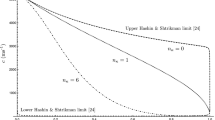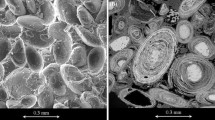Abstract
The “THHMD” damage model presented in this article is dedicated to non-isothermal unsaturated porous media. The proposed frame is based on the use of independent state variables (net stress, suction and thermal stress). Stress/strain relations are derived from a postulated expression of the free energy, accounting for the existence of residual strains. The damaged mechanical rigidities are computed by applying the Principle of Equivalent Elastic Energy for each stress state variable. The influence of damage on liquid water and vapor transfers is accounted for by introducing internal length parameters, related to specific damage-induced intrinsic conductivities. The “THHMD” model has been implemented in \(\Uptheta\)-Stock Finite Element code. The mechanical aspects of the model have been validated by comparing the numerical results with experimental reference data. A nuclear waste repository model has been reproduced. The elastic predictions are in satisfactory agreement with the reference results. The parametric studies performed on damage parameters meet the theoretical expectations. Damage gets higher with higher damage rigidities. Water permeability grows with damage and with the internal length parameter.













Similar content being viewed by others
References
Arson C (2009) Etude théorique et numérique de l’endommagement thermo-hydro-mécanique des milieux poreux non saturés. Ph.D. thesis, Ecole Nationale des Ponts et Chaussées, Paris
Arson C, Gatmiri B (2008) Excavation damage in unsaturated porous media. Key Eng Mater Adv Fract Damage Mech VII 385–387:137–140
Arson C, Gatmiri B (2008) On damage modelling in unsaturated clay rocks. Phys Chem Earth 33:S407–S415
Arson C, Gatmiri B (2009) A mixed damage model for unsaturated porous media. Comptes-Rendus de l’Académie des Sciences de Paris, section Mécanique 337:68–74
Arson C, Gatmiri B (2009) Parametric study on the performance of a thm damage model for unsaturated porous media. In: Proceedings of the 1st international symposium on computational geomechanics, Juan-les-Pins, France, 29 april——1er mai 2009, pp 53–562
Bazant Z, Jirasek M (2002) Nonlocal integral formulations of plasticity and damage: survey of progress. J Eng Mec ASCE 128:1119–1149
Chiarelli A, Shao J (2002) Modélisation élastoplastique couplée à l’endommagement anisotrope pour des argilites. Revue Française de Génie Civil 6:115–130
Collins I, Houlsby G (1997) Application of thermomechanical principles to the modelling of geotechnical materials. Proc Math Phys Eng Sci 453(1964):1975-2001
Cordebois J, Sidoroff F (1982) Endommagement anisotrope en élasticité et plasticité. Journal de Mécanique théorique et Appliquée, Supplementary Volume, pp 45–60
Coussy O, Dangla P (2002) Approche énergétique du comportement des sols non saturés, chap. 4. In: Coussy O, Fleureau J-M (eds) Mécanique des sols non saturés. Hermes Science, Paris, pp 131–174
Dangla P, Malinsky L, Coussy O (1997) Plasticity and imbibition-drainage curves for unsaturated soils: a unified approach. In: Pietruszczak, Pande (eds) Proceedings of numerical models in geomechanics. Balkema, Rotterdam, pp 141–146
de Borst R, Pamin J, Geers M (1999) On coupled gradient-dependent plasticity and damage theories with a view to localization analysis. Eur J Mech A Solids 18:939–962
Dragon A, Halm D (1996) Modélisation de l’endommagement par méso-fissuration: comportement unilatéral et anisotropie induite. C R Acad Sci Paris T. 322(Série IIb):275–282
Dragon A, Halm D, Désoyer T (2000) Anisotropic damage in quasi-brittle solids: modelling, computational issues and applications. Comput Methods Appl Mech Eng 183:331–352
Durner W (1994) Hydraulic conductivity estimation for soils with heterogeneous pore structure. Water Resour Res 30(2):211–223
Fredlund D, Morgenstern N (1978) Stress state variables for unsaturated soils. J Geotech Eng Div ASCE 104(11):447–466
Gatmiri B (2002) Framework of a non linear fully coupled thermo-hydro-mechanical behaviour of unsaturated porous media. In: Keynote lecture of the 3rd Iranian international conference on geotechnical engineering and soil mechanics. Teheran, Iran
Gatmiri B (2005) Non linear behaviour of a multiphase engineering barrier in nuclear waste disposal. In: Proceedings of 16th ICSMGE. Osaka, Japan, pp 2261–2264
Gatmiri B, Arson C (2008) Theta-stock, a powerful tool for thermohydromechanical behaviour and damage modelling of unsaturated porous media. Comput Geotech 35:890–915
Gatmiri B, Seyedi M, Delage P, Fry F (1997) A new suction-based mathematical model for thermo-hydro-mechanical behavior of unsaturated porous media. In: Proceedings of the 6th international symposium on numerical models in geomechanics, NUMOG VI. Quebec, Canada, pp 291–296
Gens A, Garcia-Molina A, Olivella S, Alonso E, Huertas F (1998) Analysis of full-scale in situ test simulating repository conditions. Int J Numer Anal Methods Geomech 22:515–548
Halm D, Dragon A (2002) Modélisation de l’endommagement par mésofissuration du granite. Revue Française de Génie Civil 17:21–33
Hansen N, Schreyer H (1994) A thermodynamically consistent framework for theories of elastoplasticity coupled with damage. Int J Solids Struct 31(3):359–389
Homand F, Chiarelli A, Hoxha D (2002) Caractéristiques physiques et mécaniques du granite de la vienne et de l’argilite de l’est. Revue Française de Génie Civil 6:11–20
Houlsby G (1997) The work input to an unsaturated granular material. Geotechnique 47(1):193–196
Kachanov M (1992) Effective elastic properties of cracked solids: critical review of some basic concepts. Appl Mech Rev 45(8):304–335
Lemaître J, Desmorat R (2005) Engineering damage mechanics. Ductile, creep, fatigue and brittle failure. Springer, Berlin
Martino J, Chandler N (2004) Excavation-induced damage studies at the underground research laboratory. Int J Rock Mech Min Sci 41:1413–1426
Mertens J, Bastiaens W, Dehandschutter B (2004) Characterization of induced discontinuities in the boom clay around the underground excavations (urf, mol, belgium). Appl Clay Sci 26:413–428
Philip J, de Vries D (1957) Moisture movement in porous materials under temperature gradients. Trans Am Geophys Union 38(2):222–232
Pires-Domingues S, Costa-Mattos H, Rochinha F (1998) Modelling of nonlinear damage on elastic brittle materials. Mech Res Commun 25(2):147–153
Pollock D (1986) Simulation of fluid flow and energy transport processes associated with high-level radioactive waste disposal in unsaturated alluvium. Water Resour Res 22(5):765–775
Pruess K, Wang J, Tsang Y (1990) On thermohydrologic conditions near high-level nuclear wastes emplaced in partially saturated fractured tuff.2. Effective continuum approximation. Water Resour Res 26:1249–1261
Shao J, Zhou H, Chau K (2005) Coupling between anisotropic damage and permeability variation in brittle rocks. Int J Numer Anal Methods Geomech 29:1231–1247
Sulem J, Ouffroukh H (2006) Shear banding in drained and undrained triaxial tests on a saturated sandstone: porosity and permeability evolution. Int J Rock Mech Min Sci 43:292–310
Swoboda G, Yang Q (1999) An energy-based damage model of geomaterials 1. Formulation and numerical reults. Int J Solids Struct 36:1719–1734
VanGenuchten M (1980) A closed-form equation for predicting the hydraulic conductivity of unsaturated soils. Soil Sci Soc Am J 44:892–898
Zimmerman R, Hadgu T, Bodvarsson G (1996) A new lumped-parameter model for flow in unsaturated dual-porosity media. Adv Water Resour 19:317–327
Acknowledgments
This research has been supported by the European project TIMODAZ (Thermal Impact on the Damaged Zone Around a Radioactive Waste Disposal in Clay Host Rocks), launched by EURATOM (European Community of Atomic Energy).
Author information
Authors and Affiliations
Corresponding author
Rights and permissions
About this article
Cite this article
Arson, C., Gatmiri, B. Numerical study of a thermo-hydro-mechanical damage model for unsaturated porous media. Ann. Solid Struct. Mech. 1, 59–78 (2010). https://doi.org/10.1007/s12356-010-0009-x
Received:
Accepted:
Published:
Issue Date:
DOI: https://doi.org/10.1007/s12356-010-0009-x




